Your Planets
Portraits of the Planets
Aspects between Planets
The planetary ages
The planetary families
Planets in Signs
The Planets in comics


Along with the Elementary doctrine (attribution of the four Elements to the major zodiacal trines and to the Planets), that of the planetary Masteries (Domicile, Exaltation, Fall, Exile) constitutes one of the essential foundations of what it is agreed to call, in this end of 20th century, “traditional” astrology, which it would be more accurate to describe as “symbolist”.
The idea that each zodiac sign is “naturally” associated with a star that governs it is for most astrologers such evidence that practically none of them even think of specifying or recalling its foundations. Thus, whatever the differences in approach that characterize them and the sometimes antagonistic philosophies that underlie them, almost all of the astrology schools does it agree on at least two dogmas: Elemental nature of Signs and the intangibility of the planetary Masteries.
The postulate according to which each star of the solar system would govern a portion of the zodiac is however not obvious. A 20th-century astrologer, with a critical and rational spirit, anxious to base astrology on serious astronomical bases, is therefore entitled to question the nature of the star-Sign relationship in general and the relevance of the Mastery system especially traditional.
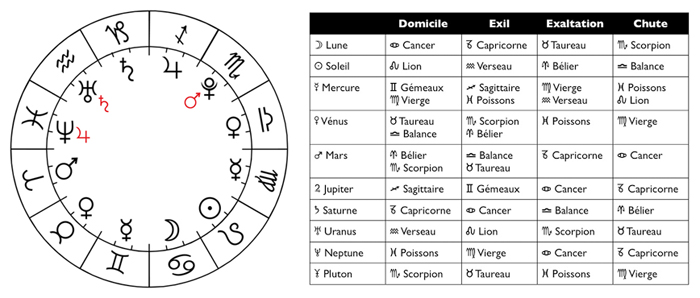
This is what this article sets out to do. At first, it seemed to me necessary to go back in time, in order to find the sources of the theory of the Masteries; secondly, to expose the astronomical arguments that plead against the reality of the Masteries; and thirdly, to demonstrate how pernicious the use of this system can be, both in theory and in astrological practice.
To illustrate our point, let us quote the writings of three authors of the 20th century, which fairly well represent some of the main trends in symbolist astrology. According to A. Barbault, “the ancients did not fail to establish precise relationships between these two coupled values (Sign and Star). Their first findings led them to place each Sign under the guardianship of a planet.” For Hades, “the planet is said to be ‘in domicile’ in its sign”. For Dane Rudhyar Finally, “Each planet is said to ‘rule’ one or even two Signs, and to be ‘exalted’ in another”.
“We” (completely indefinite pronoun) has a good back, and the reference to the ancients, with or without capital letters and all the respect we owe to those of them who deserve it, is certainly not enough to justify the dogma of the Masterships. Unless, of course, you postulate that the anteriority of any theory is an absolute criterion of validity. We know that the history of knowledge, in many fields, has largely shown us the opposite. Astrologers of the end of the second millennium, we are dependent on the heritage bequeathed to us by the ancients. It is up to us to make it bear fruit… but it would be a great disservice to astrology to reproduce and allow the errors of our ancestors to persist.
According to the historical documents that we have, it was during the meeting of Babylonian astrology with Greek civilization that the doctrine of planetary Masteries, as we know it today, was systematized.
Two great traditions nourished Greek astrology: the Chaldean, plus “physics” and the Egyptian, more metaphysical. It seems that it was the Chaldean astrologers who first began to assign domiciles to the planets.
Let us recall that, when Babylonian astrology was established, the phenomenon of precession of the equinoxes was still unknown; also the Chaldeans, and after them the Egyptians, had attributed to the constellations which were in the background of the ecliptic band the qualities of the Signs. For the Greeks therefore, as Bouché-Leclercq notes, “it was a philosophical question to be debated whether, in the collaboration of the Signs and the planets, the harmony came from the fact that the planets distributed the influence of the stars, or on the contrary, from the fact that the stars participated in the nature of the planets and adapt to their temperament. The astrologers had decided the question of practice in favor of the planets.”
Why this choice? Probably because the more discerning of them had noticed that the planetary influences were stronger and more significant than the zodiacal ones (confused with the stellar ones before the discovery of the precession of the equinoxes), which centuries of observation have since largely confirmed. From the primacy of the stars over the Signs, they then inferred that there was a hierarchical relationship between the star and the Sign: thus, in general, the stars “commanded” to the Signs.
Analog thinking, which at that time dominated almost unchallenged, then took over. One can imagine the reasoning of our distant Chaldean ancestors: the Sun is the most important and hottest star; however, it is at the time of the summer solstice that it is highest in the sky and that the periods of greatest heat begin in the Mesopotamo-Egyptian latitudes. Doesn’t the Sun govern the period with the longest sunshine durations and the hottest season of the year? As for Saturn, it is the farthest star from the Sun, therefore the farthest from its heat, therefore the coldest… Wouldn’t the winter solstice be its domain, and especially the winter season, during which one is the coldest?
With this in mind, it might seem logical to think that the Sign most in affinity with the Sun was Cancer. A certain Nigidius Figulus, hermetic Egyptian disciple of Hermes Trismegistus, had moreover made the Sun the governor of Cancer, placing the domicile of the Moon in Leo! This is to tell you if the mastery system did not come out fully constructed from the thigh of Jupiter…
That said, why the domiciliation of the Sun in Leo? Perhaps we should look for its origin in Egyptian astrology. Essentially zodiacal, it attached the greatest importance to the fixed stars, while devoting a real cult to the Sun (Ra). However, it so happens that many papyri mention that at the time when the “zodiac religion” Egyptian, the heliacal rising of Sirius (Sothis), a star to which the Egyptians granted an important influence, occurred in the direction of the constellation of Leo. By giving the Sun a domicile in Leo, the Egyptians killed two birds with one stone, paying homage to both Sothis and Ra. This perhaps explains it, and all the more so since it was in the heart of summer, whose torrid heat was analogous to that of the daystar, that the floods of the Nile were in full swing, bringing with they wealth and fertility…
But, with regard to the distribution of the other planetary Masteries, it seems that we must leave the Egyptian school to understand them. The Egyptians, more metaphysicians than physicists, unlike the Chaldeans and later the Greeks, cared little for the concrete planets, preferring them, with the exception of the Sun and the Moon, their imaginary gods. The papyri dated from 90 to 190 AD reporting the system of Planetary Masteries clearly show a Pythagorean, and therefore Greek, influence.
In those remote times, the Greeks had not yet grafted their theory of the four Elements onto Babylonian astrology. They never did. Our fellow astrologers, who then practiced an astrology of largely meteorological origin, could then practically observe that just after the summer solstice, while the Sun was crossing Cancer, the weather was hot and dry. It was only much later, around the 15th century, that it has become, by Elemental-abstract decree, a cold and humid Water Sign.
Let us therefore admit that the Egyptians have the paternity of the domiciliation of the Sun in Leo through the heliacal rising of Sirius. Why would the Moon then be domiciled in Cancer? No natural reason a priori legitimizes this attribution: the Moon, star of cold nights, antithesis of the hot Sun, apparently has nothing to do in this equinoctial sign where the nights are the shortest and the days the longest. The Pythagorean tradition then comes to our aid, which gave the planets the following order: Moon, Sun, Mercury, Venus, Mars, Jupiter, Saturn. By preserving the Sun’s mastery of Leo, by adopting the Pythagorean order and by respecting the meaning of the Signs, one inevitably ends up with the following masteries:
This is what a Gnostic tradition, supposedly Egyptian and in fact derived from Hellenistic speculations, called the world chart. According to this tradition, this chart would describe the positions that the planets occupied in the zodiac at the birth of the universe, each being ideally in domicile, the Moon in Cancer in AS and the MC in Aries at the time of the universe big Bang or what took its place at the time…
We think what we want of such wanderings but, thanks to this system, the seven wandering stars, ancient homeless of the sphere of the fixed ones, finally had a fixed domicile. Phew! But what about the other five Signs? Why wouldn’t they also be entitled to planetary Masteries? Our fellow astrologers ended up finding a simple and elegant solution.
The Sun and the Moon, by a privilege due to their condition of luminaries, would have only one domicile and would each reign over two hemispheres: a hemisphere of mastery “diurnal” governed by the Sun (Mercury-Virgo, Venus-Libra, Mars-Scorpio, Jupiter-Sagittarius and Saturn/Capricorn, the Moon having no daytime domicile since it is the star of the nights) and a hemisphere of mastery nights ruled by the Moon (Mercury-Gemini, Venus-Taurus, Mars-Aries, Jupiter-Pisces and Saturn-Aquarius, the Sun having no nocturnal domicile since it is the star of the day).
Everything is then for the best in the best of all possible worlds: with seven stars, we have managed to distribute twelve Masteries harmoniously distributed. Admittedly, the system totally lacks symbolico-natural logic. If it had one, the Sun, star of the day, would analogically govern the Signs surrounding the summer solstice (Gemini-Cancer), the sunniest period of the year, and the Moon, star of the nights, could for example to be in domicile in the Signs bordering on the winter solstice (Sagittarius-Capricorn), the time of the longest nights.
But no external logic! The majority of our astrologer ancestors seemed to be satisfied with the internal logic of this system of planetary Masteries… even if this internal logic was more than doubtful: indeed, the planets were supposed to have a sex. Moon and Venus were considered feminine, Sun, Mars, Jupiter and Saturn masculine and Mercury androgynous. Were these “devirilized” when they were under the control of the night Signs of the hemisphere of the lunar Masteries? And vice-versa: Were Moon and Venus becoming more masculine in their daytime domiciles in Cancer and Libra? Our distant colleagues do not seem to have asked the question.
Still from the point of view of the strange internal logic of this system, the problem was solved, since the Signs also had a sex: the feminine Moon could only govern a feminine Sign like Cancer and the Sun, masculine, that a masculine Sign like Leo. Very well, but then why does Venus, feminine planet, have its daytime domicile in the masculine sign of Libra, and Mars, masculine, in the feminine sign of Scorpio? Ptolemy, any more than anyone else, has seen fit to explain to us the why and how of such gross inconsistencies.
Mars in Aries in its nocturnal domicile located in a hemisphere governed by a female star, the Moon, is it more or less “masculine” than Mars in Scorpio, masculine in a feminine Sign but in a hemisphere ruled by the masculine Sun? Don’t worry, the Greek astrologers had the answer to everything, and if you asked them which of its two domiciles preferred the planet which had two, they would answer you: the one that corresponds to its sex… which formally contradicts the primacy of the diurnal domiciles. on nights.
Such a system is completely aberrant. And that’s not all. The diurnal and masculine hemisphere (solar) and the nocturnal and feminine (lunar) are separated by a diameter that passes between, on one side Cancer and Leo, on the other Capricorn and Aquarius. Logic would require that the Signs belonging to the hemisphere of nocturnal domiciles (from Aquarius to Cancer included) have night durations greater than that of days, and vice versa for diurnal domiciles (from Leo to Capricorn included). However, it is exactly the opposite that occurs; Worse still, the hemisphere of the diurnal domiciles contains the two Signs with the longest nocturnal durations (Sagittarius-Capricorn), and the nocturnal hemisphere the two Signs with the maximum diurnal durations (Gemini-Cancer).
And too bad if the Moon, star of the night according to legend, is also the star of the day during the new Moons, when it completes its entire trajectory above the horizon in the company of the Sun. There is reason not only to lose one’s Latin there, but also to reject Greek astrology and its system of planetary masteries…
The system of planetary domiciliations is, you see, quite absurd. What then of that of exaltations? In the minds of Greek astrologers, exaltation (or altitude) was the Sign where the planet acquires or begins to acquire its maximum power. This definition is totally vague and equivocal, and mixes several astronomical phenomena: sometimes it is about the southern and northern declinations of the planets (the star is then exalted when it begins to rise in altitude in the sky. Ex: the Sun is “exalted” in Aries because its North declinations increase and it is therefore higher and higher in the sky), sometimes it is about the apogees and perigees of the stars (a star at the point of its course on the ecliptic the most distant from the Earth being supposed to be exalted).
It makes no sense. And if you’re wondering why Saturn is exalted in Libra, don’t look for any astronomical reason: it’s quite simply because, his nocturnal domicile (Aquarius) being opposed to the Sun’s domicile (Leo), he is necessarily (?!) exalted. in the Sign diametrically opposed to the Sign of exaltation of the Sun, the latter being in “depression” (it is the expression designating the fall) in Libra, QED! In the same vein and following the same delusional logic, since the Moon is exalted in Taurus, Saturn (whose domicile in Capricorn is opposite to that of the Moon in Cancer) should be exalted in Scorpio… but Ptolemy, nor any no other astrologer of the Hellenistic period says a word about it.
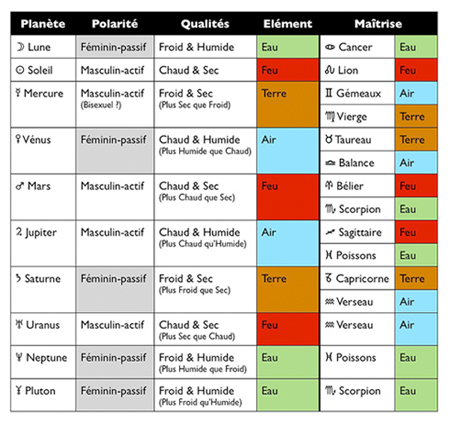
All these illogicalities, these absurdities, are to a large extent the product of an unbridled analogism. But what is analogy, which most astrologers believe is a royal road to accessing the mysteries of the relationship between Man and Heaven? Let us give the floor to an astrologer, Henri Gouchon: “Two phenomena are, by definition, in analogy when one finds in the second characteristics already encountered in the first… the preliminary question remains as to whether, from the first to the second of the elements considered, the analogy operates by virtue of a simple parallelism, correlation or cause and effect relationship.”
Analogical thought is therefore thought that seeks and establishes relations of resemblance or correspondence between different beings, objects or situations, without worrying about whether these relations arise from objective physical causes. It is a magical, animist, purely symbolist thought, common to the primitive and to the child. Should it be brought to trial, on the pretext that our distant astrologer ancestors used and abused it, among other things in their theory of planetary mastery? Obviously not. It would be as stupid as blaming a child for not being a logical and rational adult.
Analog thought is the knowledge of childhood at the same time as the childhood of all knowledge, including astrological knowledge. It also represents “any initial approach of a mind, even an adult, placed before a problem whose unusual or complex character sends it back to the use of its primordial function. Well integrated with other psychological functions, the animist tendency has creative virtues of which we cannot deprive the human race. Moreover, it corresponds to a stage of development that seems difficult to suppress if we value the appearance and the accomplishment of the next stage!” (2).
The analogism allowed our distant ancestors astrologers, in the childhood of astrology, to grasp the correspondences between Man and Heaven. They had no choice but to think otherwise. It is at the heart of this analogical soil on which it has been nourished that logical thought has gradually emerged, demanding that the correspondences between the elements of reality, when they exist, be based on objective and measurable physical causes, such as a little man coming out of childhood and realizing that the stars are not poetic fireflies, but masses of gas in thermonuclear fusion.
There is therefore no question of rejecting analogical thinking altogether, and even less of instructing the trial. But it is essential to go beyond it and to unravel, in the dense web of correspondences that it has established, what is apparent and often illusory resemblance, and what is objective correlation. However, it seems obvious today, thanks to the progress of our knowledge, that the theory of planetary mastery comes more from the first category than from the second…
In the centuries following the publication of the Tetrabiblos of Ptolemy, this absurd system imposed itself and was adopted by generations of astrologers. Few were those who dared to criticize it, even to reject it. Only Kepler, it seems, did so explicitly in his Harmonia Mundi. So much so that he, who was not only strongly marked by Capricorn (Sun-Mercury-Venus conjunction in this Sign, plus Uranus, whose existence he could not have known at his time), but also a rigorous scholar, refused in his self-portrait astrological to define himself as a Saturnian, on the pretext, fallacious according to him, that Saturn would be the ruler of Capricorn. And besides, Saturn is not angular in its chart. That is to say!
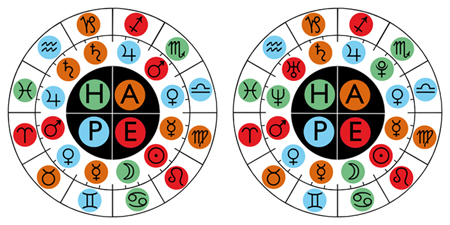 In 1781, the existence of a first transsaturnian: Uranus. Immediately, there is panic among astrologers: the beautiful multi-hundred-year-old edifice of planetary mastery has just suffered a first crack. We have to find him a home again! Explicitly or implicitly, the logic of “daytime domiciles” prevailed: by following the direction of the Signs and following Saturn in Capricorn, Uranus finds himself promoted master of Aquarius, sign of Air (because since the beginning of the first millennium AD, the elemental zodiac began to reign unchallenged… although Ptolemy made no reference to it!). Bizarre, for a star-myth assimilated to Prometheus, who stole the fire (Fire) from the gods. Is Air the enemy of Fire? Serious question… As for Saturn, who previously occupied the throne, he must now be content with a function of viceroy… and the beautiful internal logic “traditional” who presided over the homes has indeed been shattered.
In 1781, the existence of a first transsaturnian: Uranus. Immediately, there is panic among astrologers: the beautiful multi-hundred-year-old edifice of planetary mastery has just suffered a first crack. We have to find him a home again! Explicitly or implicitly, the logic of “daytime domiciles” prevailed: by following the direction of the Signs and following Saturn in Capricorn, Uranus finds himself promoted master of Aquarius, sign of Air (because since the beginning of the first millennium AD, the elemental zodiac began to reign unchallenged… although Ptolemy made no reference to it!). Bizarre, for a star-myth assimilated to Prometheus, who stole the fire (Fire) from the gods. Is Air the enemy of Fire? Serious question… As for Saturn, who previously occupied the throne, he must now be content with a function of viceroy… and the beautiful internal logic “traditional” who presided over the homes has indeed been shattered.
Less than a century later, in 1846, Neptune was discovered in turn. Panic again, but a little less: still following the logic of daytime domiciles and the meaning of the Signs, we assign him a domicile in Pisces. That’s good, the god of the seas in a Water Sign, and moreover named Pisces! It is jubilation among symbolist astrologers, and Kepler is turning in his grave. The two figures above represent the planetary Masteries over the Signs, the Elements being represented by colors: red for Fire, brown for Earth, blue for Air and green for Water. The figure on the left represents the Masteries “traditional”, those before the discovery of the transsaturnians, and the one on the right the neo-Masters.
Eighty-four years passed, and Pluto was seen at the end of a telescope in 1930. The same logic, stemming from the Greek astrological tradition, which presided over the domiciliary attributions of Uranus and Neptune would like us to make Pluto the ruler of Aries. However, this will not be the case. Some rare astrologers certainly attribute Aries to him, but others pinch for Sagittarius (Volguine) or Pisces (Vouga).
Finally, it is Scorpio who wins at the finish, and the traditional system of mastery is now well and truly pulverized: with Pluto master of Scorpio, he no longer has either internal logic or external logic. The astrologers who believe in the mastery of Pluto over Scorpio are in total rupture with Tradition… even though, paradoxically, it is among them that we find the most ardent defenders of the Greek astrological heritage! To plead their case, they point to the similarities between plutonian astro-psychological characteristics and those of the eighth Sign, and the obvious dissimilarity between the dark and strange Pluto and the frank and clear Aries.
We know, however, how much the Ancients held to the internal logic (?) of their planetary mastery. To legitimize it, they have in no way carried out a systematic evaluation of the “similarities” or “dissimilarities” astro-psychological between stars and signs. Once postulated, from an alleged “natural reason” supported by a tautological approach that the two luminaries were domiciled in Cancer and Leo, and that the distribution of domiciles had to imperatively follow the Pythagorean planetary order, it is with a cold and abstract spirit of system, exempt from any astrological consideration. psychological, that they distributed the degrees. And it was only once this operation was accomplished that they began to be interested in the analogies between domiciles and their masters: an attitude which is very exactly the opposite of those who plead in favor of astro-psy similarities between Pluto and Scorpio.
What are the objective phenomena that can rationally establish the star-sign relationship? Beyond the symbols and analogies with which man dresses up and sometimes disguises reality, it is undoubtedly towards astronomical realities that we must turn to find elements of an answer.
In the past, all serious astrologers (Ptolemy, Kepler, Cardan to name a few) were astronomers at the same time: even when they were wrong, they generally knew what they were talking about. Nowadays, too many astrologers are unaware of almost everything about astronomical reality, which is nevertheless the basis of astrological reality. The zodiac and the planets have thus become pure linguistic abstractions with which one can juggle intellectually, as if they had no reality in themselves.
At the time of the birth of Hellenistic astrology, it must be recognized that, as today, astrologers-humbugs, ignorant of the things of astronomy, were already legion. Thus it is customary to imagine the zodiac as a kind of mythical circular ribbon, about 17° wide and of indefinite radius, which would turn around the Earth and on which would circulate no less mythical stars of the solar system and all kinds of dummy points (Black Moon, imaginary planets, various Parts, etc). This ribbon would be subdivided into twelve equal parts and would have a “solar essence”. Each of these twelve zodiacal sectors would have an Elemental quality (Fire-Earth-Air-Water) and would be governed by one or two celestial bodies.
The astronomical reality is quite different.
In fact, astronomically, the zodiac has no other reality than geocentric: it is the inclination of the Earth in its orbit. It is therefore of terrestrial essence, and not solar.
If the axis of the Earth were not tilted on its orbit, the apparent solar rotation would take place in the equatorial plane and there would therefore be no intersection between the ecliptic plane and the equatorial plane, no boreal declinations or australs, neither solstices nor equinoxes and consequently no variation of diurnal and nocturnal durations, and ultimately no zodiac.
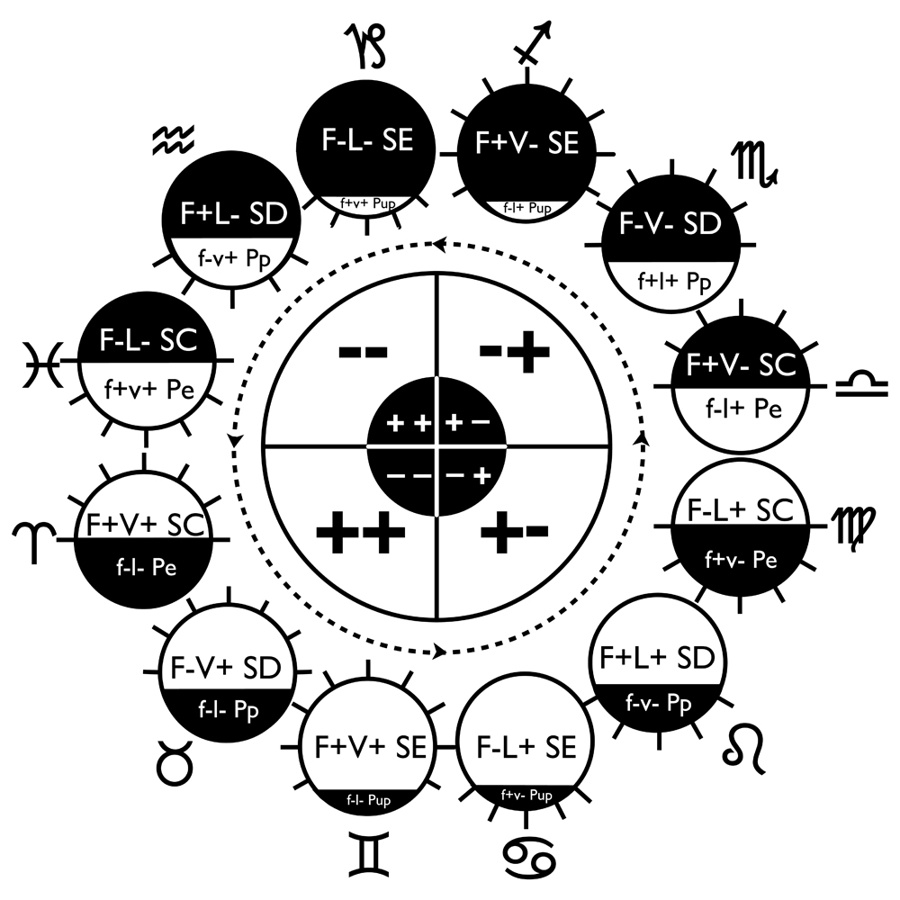
The Signs of the zodiac do not, at bottom, derive their objective reality and their concrete meanings only of their variations and of the ratio of their diurnal and nocturnal durations, their balance, their increasing or decreasing character. And these variations of the diurnal-nocturnal durations (for the Sun) and of the times of presence-absence with respect to the plane of the horizon (for the Moon and the planets) are themselves induced by the declinations, which are due to the tilt of the Earth in its orbit…
The zodiac is therefore in no way of solar essence. It follows that it is also not seasonal, the earth’s seasons being determined by the annual increase and decrease in sunshine durations. The seasonal, and therefore solar, conception of the zodiac, moreover, produces absurd results: imagine an individual having the Sun in Leo, Mars in Libra, the Moon in Capricorn and Jupiter in Taurus. So he was born in summer, season “hot and dry”. If we stick to the solaro-seasonal conception of the zodiac, the fallen leaves should begin to cover Mars in Libra (it is in autumn “dry and cold”), snow should fall on the Moon in Capricorn (it is in winter “cold and wet”) while daisies would be said to flourish in the verdant grass of mid-spring for Jupiter in Taurus (it is in spring “hot and humid”).
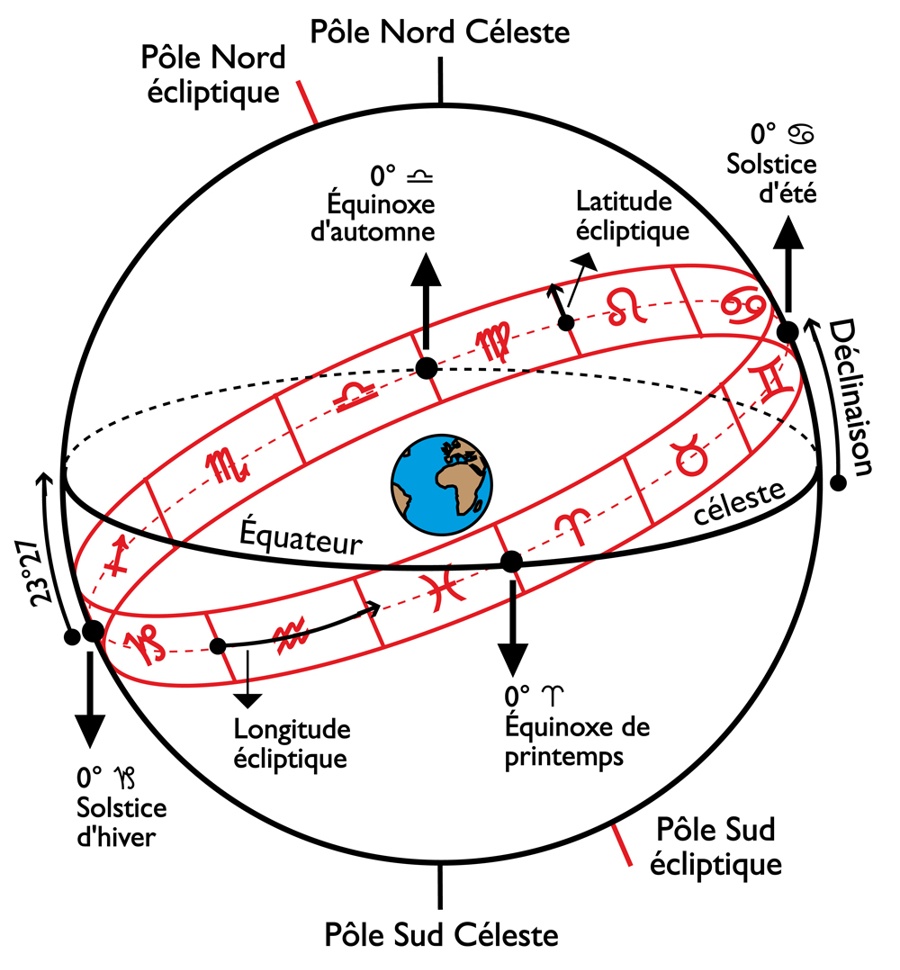
What happens in reality? Nothing of the sort. It’s summer for all the planets, and it’s not snowing in any corner of our subject’s natal chart: good for him, he would risk hot and cold! More seriously, consider the case of the Moon: it is not “in winter” and it is not cold on the 30° zodiac of Capricorn: it simply occupies a position between −23.45° and −20.16° of south declination, therefore in the Sign of Capricorn, which is worth a duration of presence above the horizon of between 8 h 03 and 8 h 43 for the latitude of Paris.
The ecliptic, apparent trajectory of the Sun around the Earth, serves as a zodiacal reference plane: the zodiacal longitudes of the planets, found in our ephemeris, are calculated from the projection of their real position on the ecliptic plane. However, it should not be forgotten that the planetary orbits are all inclined with respect to the ecliptic plane, and that the planets therefore do not faithfully follow the solar trajectory. This height, positive or negative, with respect to the ecliptic plane is called the celestial latitude. It is because of these celestial latitudes that the zodiacal band has been conventionally widened by about 8° 30′ on either side of the ecliptic.
You will tell me: “But what does this have to do with masteries?” I’m coming. Take the case of Pluto, whose domicile is supposed to be Scorpio. Its perihelion (minimum distance from the Sun) is in the direction of 21° Scorpio. At its perihelion, Pluto, whose orbital plane is inclined by about 17° on the ecliptic, has a strong northern celestial latitude (+14° 28′), and therefore a declination greater than that of the Sun at 21° Scorpio. To verify this, take our ephemerides for the date of 1/12/1991, the date on which the position of Pluto, projected on the ecliptic plane, is precisely 21° Scorpio, and note its declination: it is −4° 01′ south.
Let us now find out on what date the Sun has the same declination: it is 04/10/1991, and the Sun is then at 10° Libra. Pluto at 21° Scorpio therefore has the same zodiacal characteristics (declination, presence-absence time above the horizon) as the Sun at 10° Libra. Let’s generalize: when Pluto is in the first decan of Scorpio, he has Virgo rhythms, and in the last two decans of Scorpio, Libra rhythms. Logic would then require interpreting a Pluto in ecliptic longitude at the end of Scorpio as a Pluto-Libra. You can now see where I’m going with this example: Pluto is currently in Scorpio, so apparently “in dignity” in his home. Those who believe in planetary mastery have drawn and still draw from it all sorts of conjectures on the individual and collective level, whereas in reality Pluto behaves like a star in Libra…
Notice to the population fond of Masteries: it is only from 17/10/2000 that Pluto will begin to have real Scorpio rhythms, until 15/02/2014. It will then pass, in ecliptic longitude, from 11° Sagittarius to 13° Capricorn.
The case of Pluto is extreme: indeed, it is the star whose orbital plane is the most inclined with respect to that of the ecliptic. But the orbital planes of all the planets being more or less inclined on the ecliptic, we could deduce, in all astronomical-astrological rigor, that each planet has its own zodiac, that it is the “mistress”, and that only she is there “at home”.
To better assess the profound absurdity of the system of planetary rulers, let us take the example of Pluto at 21° Cancer on 03/12/1930 and describe some of the aspects of this celestial phenomenon:
▶ 1. The planet Pluto, whose sidereal revolution time is 247.7 years and which is on average at a distance of about 4,276,000 km from Earth…
▶ 2. …has a declination of +21° 58′ north (geocentric datum due to the tilt of the Earth in its orbit) and an ecliptic latitude of +0° 06′, which is a Gemini declination…
▶ 3. … and at the latitude of Paris, its diurnal arc (time of presence above the horizon) is 15 h 20 (topocentric frame of reference, specific to the latitude of the place of terrestrial observation).
This rational description shows that the Sign is only ever a geocentric frequency of the star. The Sign has no existence in itself. If we remove Pluto and its astronomical features from this description, all that remains is the declination and diurnal arc of a nonexistent celestial object: “A sign without a planet is an astronomical abstraction.”
This star-Sign relationship being rationally established, we can then, as André Barbault says for example, think that “a play of interferences is established where the planet finds itself toned by the values of the Sign, at the same time as the sign finds itself in a way colored by the tendencies of the planet”, knowing however that the planet will not change in nature by changing Sign: astrology is planetary before being zodiacal.
Let’s take a new example: Mars in Aries. The star is then “at home” in one of “his” Signs:
▶ 1. The planet Mars, whose sidereal revolution is 1 year 322 days and which is at a distance of between 55 and 400 million km from the Earth…
▶ 2. … has a declination between +0° and +11.48° north if it has no ecliptic latitude…
▶ 3. … and at the latitude of Paris, its diurnal arc is between 12 h and 13 h 48.
By what miracle would the planet Mars, which is on average hundreds of millions of kilometers from the Earth, be the “master” of an ecliptic section, the “owner” of a portion of the zodiac, in short the “governor”, dignified and delighted, by a fraction of the inclination of the Earth in its orbit? Can you imagine the enormity, the absurdity of this assertion? For what logical reasons would Mars be “in dignity” when its declination is 5° north (Aries) and “debilitated” when it is 15° north (Taurus)?
And what happens when Mars, without celestial latitude, is exactly at 11.48° north declination, i.e. exactly on the border between Aries and Taurus? Is he worthy or stupid? Debilitating? Dignodébile? Domiciled or homeless? And if the AS is located exactly at 0° Taurus, that is to say at 11.48° of declination north, the master of AS — which competes, according to mastery astrology, as the dominant —, is it Mars or Venus? Needless to say, such delusions delight our adversaries, the rationalist anti-astrologers. They draw from it excellent and legitimate reasons to think that astrology can in no way claim the status of science.
Do certain geocentric frequencies of the stars (certain Signs therefore) promote an enhancement of their intrinsic characteristics? Are some other frequencies able to antagonize them? Is Mars more at ease when it is at 5° north declination (Aries), with a time of presence above the horizon comprised, for the latitude of Paris, between 12 h and 13 h 48?
If this is indeed the case, it means that the marsian function has a “preference” for the increasing northern declinations and for the diurnal durations almost equal to but noticeably greater than the nocturnal ones, which “correspond” better than others. Why not? But then, how is it that the same Mars has an affinity, a preference (a “domicile” in the terminology of the masters) for Scorpio, a sign which is characterized by an increasing southern declination from −11.48° to −20.16°, which induces for the latitude of Paris a diurnal arc between 10 h 12 et 18 h 42, which means that increasing southern declinations and nighttime durations much longer than daytime are his preference this time?
The only astronomical point in common between Aries and Scorpio is the growth of their declinations, a characteristic they share with Taurus, Gemini, Libra and Sagittarius. If we want to be (astro)logical, Mars should therefore be in domicile in all the Signs of Spring and Autumn. But Mars also has a “preference” for Capricorn, since it is their Sign of exaltation. However, a star in Capricorn without celestial latitude has a decreasing southern declination between 23.45° and 20.16°, which corresponds for the latitude of Paris to a diurnal arc between 8 h 03 and 8 h 43 … Mars would therefore also have an affinity with very short durations of presence above the horizon…
Let us note in passing another absurd effect of the theory of mastery and exaltation when combined with that of aspects: Mars is master of Aries and exalted in Capricorn, a sign which is at 90° from Aries. Which means that when Mars forms its waning square (known aspect “malefic”) at his home, he is in full elation. This concept of “evil exaltation” has not been dug enough by those who defend planetary masteries. On the other hand, the solar domicile (Leo) is at 120° (trine) from its Sign of exaltation (Aries)… As for Saturn, ruler of Capricorn and Aquarius, it is both squared and at the trine of its place of exaltation (Libra). Is it necessary for this reason to forge the concept of “beneficial-malefic exaltation”? And where is the logic in all of this?
The same considerations apply to the masteries and exaltations of the other planets. There is absolutely no natural logic in the distribution of domiciles, and therefore no more in that of falls and exiles. The alleged “affinities” have no objective basis. There is therefore reason to doubt their existence. “A planetary function is expressed as such in the Sign (geocentric rhythm) where it is at a given moment of its cycle. There can therefore be no contradiction in the star-Sign relationship… A planet expresses in any Sign the riches and deficiencies specific to its nature and its function. In itself, the presence in a Sign rather than in another can in no way prejudge its strengths and weaknesses, its adapted or unadapted tendencies.”
Let there be a “precise relationship” between star and sign is obvious. That this relationship is strictly hierarchical (vertical), which is implied by the concept of “guardianship”, is not. However, there are other types of possible relationships, based on equality and cooperation (horizontal relationships). Admittedly, A. Barbault, for example, does not neglect to note that “the naive terminology of the Ancients (Trine, Fall) shocks the modern mind […] but rejuvenating the vocabulary, replacing these magic terms with learned, less poetic words, does not change the matter.”
André’s astro-psychology Barbault therefore adopts the theory of “guardianship” of each star on a precise sign, without justifying it other than by the reference, purely historical and cultural, to “alumni”. This hierarchical star-Sign relationship is moreover so obvious to him that, in his penultimate work, in which he also questions the qualities Elementary traditional Signs, he does not dream of redefining or specifying it. And it is without any explanation on the objective causes of this relationship of “guardianship” that he affirms, p. 77, that “the zodiac of the elements is the planetary zodiac” and that consequently, “each Sign is endowed with the element of the ruling planet”.
In practice, the systematic use of the planetary Masteries can lead to gross misinterpretations, to profound errors of interpretation. One can have an Aries zodiac dominance and not be marsian… and even have a very weak and very devalued marsian function. Have you ever met soft Aries, afflicted by a dominant and dissonant moon function? Likewise, a Cancer dominant does not imply a planetary lunar dominant: with an angular Mars, our Cancerian will not be a dreamer, and you have certainly already crossed paths with a realistic and combative Cancer who cares like a fraction of the comfort of his home Sweet Home lunar…
By way of conclusion, an example, that of Raymond Peynet, born on 16/11/1908 at 07:50 in Paris, Scorpio ascendant Scorpio in his state. The creator and draftsman of the famous, tender, romantic and cutesy “lover” should, if the doctrine of the planetary masteries is to be believed, be a dark, sexually obsessed and aggressive Marso-Plutonian… find the error!
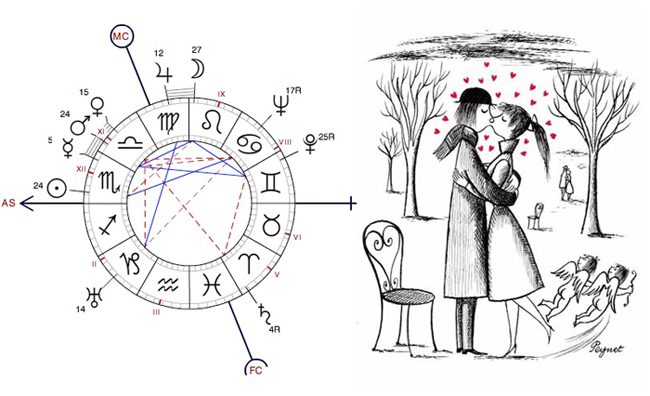
“The zodiac of the Elements is the planetary zodiac. Each sign is endowed with the Element of the ruling planet. Thus, the Fire reigns in the marsian signs of Aries and Scorpio, as in the solar sign of Leo; the Earth in the mercurian signs of Gemini and Virgo, as well as in the saturnian signs of Capricorn and Aquarius; Air in the venusian signs of Taurus and Libra, as well as in the jupiterian sign of Sagittarius; and Water in the lunar sign of Cancer and the neptunian sign of Pisces. It is the planetarism that we find here, extended in a zodiacal reconstruction, and it is this which must serve as a reference for our interpretations of the temperamental type.”
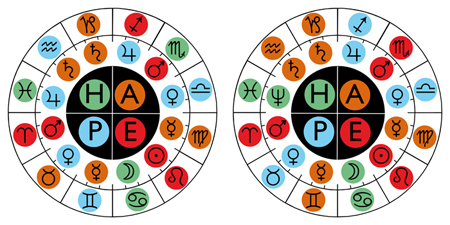 The figures opposite represent, on the left, the traditional Elements of the Zodiac Signs and the corresponding planetary Masteries, and on the right the new Elements assigned to the Signs by Barbault. We will notice the formidable logic and the perfect coherence of André Barbault: all the Signs except Pisces (why?) inherit the Element of their planet “Ruler” traditional (before the discovery of the trans-saturnians). The “Master” Traditional Pisces being Jupiter, Pisces should have been an Air Sign. But André Barbault decided otherwise, no doubt because it bothered him that there was only one Water Sign, Cancer. He therefore arbitrarily decided to include Neptune in the Tradition and to exclude Uranus and Pluto… while continuing to use the Masteries of these two non-traditional Planets on Aquarius and Scorpio in his practice. Admire the rigor…
The figures opposite represent, on the left, the traditional Elements of the Zodiac Signs and the corresponding planetary Masteries, and on the right the new Elements assigned to the Signs by Barbault. We will notice the formidable logic and the perfect coherence of André Barbault: all the Signs except Pisces (why?) inherit the Element of their planet “Ruler” traditional (before the discovery of the trans-saturnians). The “Master” Traditional Pisces being Jupiter, Pisces should have been an Air Sign. But André Barbault decided otherwise, no doubt because it bothered him that there was only one Water Sign, Cancer. He therefore arbitrarily decided to include Neptune in the Tradition and to exclude Uranus and Pluto… while continuing to use the Masteries of these two non-traditional Planets on Aquarius and Scorpio in his practice. Admire the rigor…
Article published in issues No. 4 & 5 of the Fil d’ARIANA (October 1995 & April 1996) and in L’Astrologue (4th quarter 1996).
▶ Critique of the doctrine of the four Elements in traditional astrology
▶ André Barbault et le conditionalisme
▶ Une critique inepte du conditionalisme par André Barbault
▶ André Barbault, l’astro-symbolisme et le dernier âge d’or de l’astrologie
▶ The world according to Claudius Ptolemy, astronomer-astrologer and lighthouse of Alexandria
▶ Results of traditional astrology
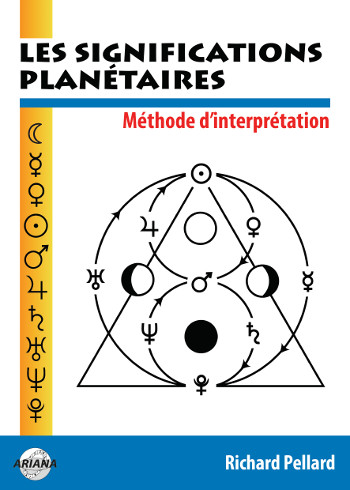
Les significations planétaires
par
620 pages. Illustrations en couleur.
La décision de ne traiter dans ce livre que des significations planétaires ne repose pas sur une sous-estimation du rôle des Signes du zodiaque et des Maisons. Le traditionnel trio Planètes-Zodiaque-Maisons est en effet l’expression d’une structure qui classe ces trois plans selon leur ordre de préséance et dans ce triptyque hiérarchisé, les Planètes occupent le premier rang.
La première partie de ce livre rassemble donc, sous une forme abondamment illustrée de schémas pédagogiques et tableaux explicatifs, une édition originale revue, augmentée et actualisée des textes consacrés aux significations planétaires telles qu’elles ont été définies par l’astrologie conditionaliste et une présentation détaillée des méthodes de hiérarchisation planétaire et d’interprétation accompagnées de nombreux exemples concrets illustrés par des Thèmes de célébrités.
La deuxième partie est consacrée, d’une part à une présentation critique des fondements traditionnels des significations planétaires, d’autre part à une présentation des rapports entre signaux et symboles, astrologie et psychologie. Enfin, la troisième partie présente brièvement les racines astrométriques des significations planétaires… et propose une voie de sortie de l’astrologie pour accéder à une plus vaste dimension noologique et spirituelle qui la prolonge et la contient.
Téléchargez-le dès maintenant dans notre boutique
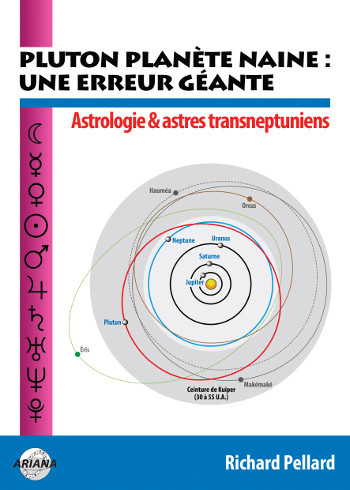
Pluton planète naine : une erreur géante
par
117 pages. Illustrations en couleur.
Pluton ne fait plus partie des planètes majeures de notre système solaire : telle est la décision prise par une infime minorité d’astronomes lors de l’Assemblée Générale de l’Union Astronomique Internationale qui s’est tenue à Prague en août 2006. Elle est reléguée au rang de “planète naine”, au même titre que les nombreux astres découverts au-delà de son orbite.
Ce livre récapitule et analyse en détail le pourquoi et le comment de cette incroyable et irrationnelle décision contestée par de très nombreux astronomes de premier plan. Quelles sont les effets de cette “nanification” de Pluton sur son statut astrologique ? Faut-il remettre en question son influence et ses significations astro-psychologiques qui semblaient avérées depuis sa découverte en 1930 ? Les “plutoniens” ont-ils cessé d’exister depuis cette décision charlatanesque ? Ce livre pose également le problème des astres transplutoniens nouvellement découverts. Quel statut astrologique et quelles influences et significations précises leur accorder ?
Enfin, cet ouvrage propose une vision unitaire du système solaire qui démontre, chiffes et arguments rationnels à l’appui, que Pluton en est toujours un élément essentiel, ce qui est loin d’être le cas pour les autres astres au-delà de son orbite. Après avoir lu ce livre, vous saurez quoi répondre à ceux qui pensent avoir trouvé, avec l’exclusion de Pluton du cortège planétaire traditionnel, un nouvel argument contre l’astrologie !
Téléchargez-le dès maintenant dans notre boutique